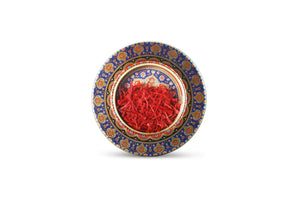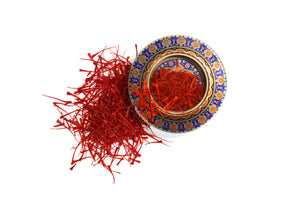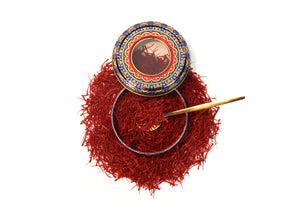Introduction
Saffron is the dried stigma of the Crocus sativus flower. It’s prized for its warm aroma, honeyed bitterness and vivid golden colour. Beyond the kitchen, people are increasingly curious about what saffron may do for general wellbeing. Here’s a calm, evidence-aware overview.
What are the potential benefits of saffron?
Saffron contains naturally occurring compounds (including crocins, picrocrocin and safranal) with antioxidant activity. Antioxidants help neutralise everyday oxidative stress in the body, which is one reason saffron has been valued in traditional cuisines and rituals for centuries.
Early research suggests saffron may support mood and emotional balance in everyday life. People often describe a gentle lift or a sense of calm when enjoying saffron as part of food or a warm drink. Similarly, some small studies indicate saffron may help with sleep quality, particularly when used as an evening infusion alongside good sleep habits.
Some evidence also points to comfort around the menstrual cycle, where saffron has been studied for easing common, mild PMS-type symptoms. In everyday cooking, saffron’s aroma can encourage mindful eating, and its colour brings pleasure to simple dishes—benefits that are subtle but real.
It’s important to keep expectations measured: saffron isn’t a cure-all, and most findings are preliminary. Think of it as a flavourful spice that may gently support wellbeing when used consistently in small amounts as part of a balanced routine.
How does saffron compare with other spices for wellness?
-
Turmeric vs saffron: Turmeric is earthy and used in larger amounts; saffron is aromatic and used sparingly. Both have antioxidant activity, but saffron’s flavour and colour are more intense per pinch, making it ideal when you want perfume and a golden hue without heaviness.
-
Cinnamon vs saffron: Cinnamon leans sweet and warming; saffron is floral-honeyed with a delicate bitterness. If you’re after a subtle mood-lifting ritual (like an evening tea), saffron offers a lighter profile that pairs well with milk alternatives and citrus.
-
Cardamom vs saffron: Cardamom is bright and menthol-spicy. Blending a pinch of saffron with lightly crushed cardamom can create a balanced, calming drink with both aroma families.
In short, saffron’s edge is its aroma, colour, and the small-dose ritual—useful when you want something gentle, fragrant and easy to digest.
How can I use saffron for everyday benefits?
Saffron shines when properly infused. A few threads go a long way, and the ritual itself can be relaxing.
Simple infusion method (for drinks or cooking):
-
Lightly crumble 8–12 threads (about 15–25 mg) between clean fingers.
-
Soak in 2 tbsp warm water or milk for 10–15 minutes until deep orange-red.
-
Add the liquid (and softened threads) to your recipe or sip as a warm drink.
Easy ideas:
-
Evening saffron milk/alt-milk: Infuse as above, then top up with 200 ml warm milk or oat/almond milk. Add a small drizzle of honey and a pinch of cardamom.
-
Citrus saffron water: Stir the infusion into still or sparkling water with a squeeze of lemon or orange; serve over ice.
-
Rice, grains and soups: Pour the infusion into cooked rice, quinoa or a light broth near the end for golden colour and aroma.
-
Yoghurt swirl: Mix a teaspoon of saffron infusion through plain yoghurt; finish with chopped pistachios.
How much?
-
Culinary use: Typically 10–30 mg (a generous pinch) per serving. This is enough for colour and aroma.
-
Upper culinary caution: Large amounts are unnecessary; very high intakes (grams, not milligrams) are not advised. Stick to small culinary pinches.
Storage tips:
-
Keep threads in an airtight jar, away from light, heat and moisture.
-
Use within 6–12 months for best aroma and colour.
Safety & Common Sense Notes (H3)
-
Saffron is a culinary spice. While emerging research is promising, we avoid medical claims.
-
If you’re pregnant, breastfeeding, on medication, or managing a health condition, speak with a qualified professional before increasing intake.
-
Avoid large doses. A little goes a long way; stay within typical culinary amounts.
-
Discontinue if you notice any sensitivity and seek advice if unsure.
Summary
Saffron offers a distinctive blend of aroma, colour and gentle ritual, with early research suggesting potential support for mood, sleep quality and menstrual comfort—best enjoyed as part of balanced daily habits. If you’d like to explore, consider starting with a small jar of high-quality threads and try the simple infusion ideas above.




0 comments